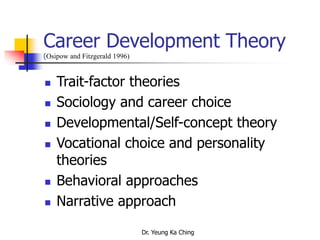Career development theory.ppt
•Download as PPT, PDF•
0 likes•19 views
Career development theory
Report
Share
Report
Share

Recommended
Recommended
More Related Content
Similar to Career development theory.ppt
Similar to Career development theory.ppt (8)
Personality theories try to unravel the nature of human beings. .docx

Personality theories try to unravel the nature of human beings. .docx
WEEK 11) The types of work professionals in specialty areas with.docx

WEEK 11) The types of work professionals in specialty areas with.docx
More from JoshuaLau29
More from JoshuaLau29 (20)
Recently uploaded
Recently uploaded (20)
POGONATUM : morphology, anatomy, reproduction etc.

POGONATUM : morphology, anatomy, reproduction etc.
Module for Grade 9 for Asynchronous/Distance learning

Module for Grade 9 for Asynchronous/Distance learning
Bhiwandi Bhiwandi ❤CALL GIRL 7870993772 ❤CALL GIRLS ESCORT SERVICE In Bhiwan...

Bhiwandi Bhiwandi ❤CALL GIRL 7870993772 ❤CALL GIRLS ESCORT SERVICE In Bhiwan...
FAIRSpectra - Enabling the FAIRification of Analytical Science

FAIRSpectra - Enabling the FAIRification of Analytical Science
Asymmetry in the atmosphere of the ultra-hot Jupiter WASP-76 b

Asymmetry in the atmosphere of the ultra-hot Jupiter WASP-76 b
PATNA CALL GIRLS 8617370543 LOW PRICE ESCORT SERVICE

PATNA CALL GIRLS 8617370543 LOW PRICE ESCORT SERVICE
development of diagnostic enzyme assay to detect leuser virus

development of diagnostic enzyme assay to detect leuser virus
300003-World Science Day For Peace And Development.pptx

300003-World Science Day For Peace And Development.pptx
Career development theory.ppt
- 1. Dr. Yeung Ka Ching Career Development Theory (Osipow and Fitzgerald 1996) Trait-factor theories Sociology and career choice Developmental/Self-concept theory Vocational choice and personality theories Behavioral approaches Narrative approach
- 2. Dr. Yeung Ka Ching Trait-factor theories The oldest theoretical approach. Assumes a straightforward matching of an individual’s abilities and interests with the world’s vocational opportunities can be accomplished and once accomplished, solved the problems of vocational choice for that individual. Strong-Campbell Interest Inventory, Kuder Occupational Interest Survey, and Aptitude tests such as Differential Aptitude Tests etc. Absorbed by many other approaches to career counseling.
- 3. Dr. Yeung Ka Ching Sociology and career choice Reality or accident theory of vocational choice Societal circumstance beyond the control of the individual contribute significantly to career choices and that the principal task confronting a person is the development of techniques to cope effectively with the environment. The degree of freedom of occupational choice a person has is far less than might be assumed. Being in the “right place at the right time.”
- 4. Dr. Yeung Ka Ching Social anchor points Two social anchor points exist to fix a person’s occupation. At one extreme is the society in which occupation is hereditary; offspring follow parents, or at least the parent’s career and life style impose rigid limits on the variety of careers children consider. At the other extreme in which occupational choice is the exclusive result of the individual’s personal characteristics. Occupational choice lies somewhere in between the two anchor points.
- 5. Dr. Yeung Ka Ching Developmental/Self-concept theory Buehler, Super, Samler, Ginzberg and Carl Rogers Individuals develop more clearly defined self- concepts as they grow older, although these vary to conform with the changes in one’s view of reality as correlated with aging. People develop images of the occupational world which they compare with their self-image in trying to make career decisions Eventual career decision is based on the similarity between an individual’s self-concept and the vocational concept of the career eventually chosen.
- 6. Dr. Yeung Ka Ching Personality theories Particular personality factors involved in career choice and career satisfaction. Personality characteristics of people in different vocations, the life styles of various professionals, psychopathology associated with professional activity, and the specific needs of worker in particular industries or jobs. The general hypothesis is that workers select their jobs because they see potential for the satisfaction of their needs. Exposure to a job gradually modifies the personality characteristics of the worker.
- 7. Dr. Yeung Ka Ching Psychological needs, values and careers Stemmed from the assumption that occupational activities are related to basic needs and that the adequacy of occupational choice improves as people are better able to identify their own needs and the potential need satisfaction offered by a particular occupation. Satisfactions result from a job which meets our needs today, or from a job which promises to meet them in the future.
- 8. Dr. Yeung Ka Ching Needs reduction approach A hungry person will take any job to obtain enough to eat. Once the need for food has been reduced, a new job which offers the potential of satisfying other physical and psychological needs will be sought. To the degree that one can find and enter jobs relevant to higher order needs, the more or less satisfied with work one will be. It seems reasonable to expect, if one postulates needs as a factor in occupational selection, that needs satisfaction is directly related to job satisfaction.
- 9. Dr. Yeung Ka Ching Occupations and mental health There is a long history of interest in the degree to which people engaged in various occupational activities display various forms of psychopathology. For example, some occupation with a tendency to alcoholism and others with particular kinds of sexual orientation (大陸貨車司机一定有二奶). Various kinds of interests and psychopathology (overall adjustment) The degree to which work settings interact with and produce stresses which cause strains to individuals leading to both work disorder and personal disorder.
- 10. Dr. Yeung Ka Ching Behavioral approaches Interest in observing individual environmental interaction in a behavioral mode. Social learning approach to career decision- making e.g. Mitchell, Jone and Krumboltz (1979) Social skills training as a career skill training approach.